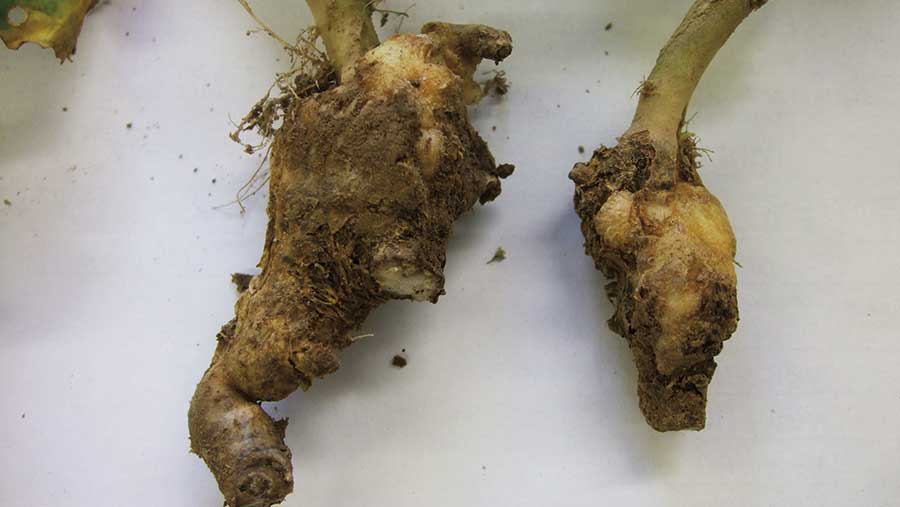Fresh reports of clubroot affecting oilseed rape crops

Concerns about clubroot in oilseed rape crops have increased this spring with reports from agronomists of fresh disease incidence in areas which previously have been unaffected.
Short rotations can lead to a rapid increase in infection, and can cause losses of 0.3t/ha for every 10% of the crop infected.
This means oilseeds should not be grown more than once every five years in affected areas, warns Will Vaughan-France, technical specialist with oilseed rape breeder Monsanto.
The issue has been on the rise in recent years as growers have sought to drill earlier, which has allowed clubroot to advance more swiftly, as it prefers warm conditions.
The disease is only controlled by rotation or by growing lower-yielding resistant varieties.
See also: Tips to help control clubroot in oilseed rape
Diagnosing the disease is easy if a problem is suspected, as the root nodules will be very apparent once the crop is dug out of the ground, says Paul Cartwright, crop production specialist with agronomy group Frontier.
Plants will only be killed outright where the taproot is affected, he explains, but if the wider root network is affected, plants will be more prone to stress throughout the season from other factors such as drought or other diseases.
Severe clubroot patch easily visible in this field nr Alton, Hants. pic.twitter.com/JltpVvzVJe
— Ben Burrows (@BenBuzzsaw) February 3, 2017
Difficult to eradicate
While the problem is difficult to eradicate, its spread can be slowed by maintaining good hygiene between fields to limit the number of soil-borne spores transported on to clean ground, says Mr Cartwright.
Reducing clubroot problems can be helped by good soil management, as the crop prefers acidic, wet conditions, meaning growers are recommended to maintain drainage and a pH level of at least seven, as well as good calcium and boron levels, says Mr Vaughan-France.
@AgriiWest one of the more unexpected discoveries this season. Club root is OSR on free draining chalk! @MRH_Agronomy @ssmshah pic.twitter.com/x3fhtjlSgY
— Todd Jex (@TJex_RegenAg) January 28, 2017
While varieties are available with resistant traits, he says growers with a low clubroot population will still see better yield results by selecting a high yielding variety and pushing it, rather than choosing a resistant variety.
Will Vaughan-France was speaking alongside others at a recent 3×3 oilseed rape spring event in Oxfordshire.

